Analysis of ASA 701 Compliance in Australian Banking Audit Reports
VerifiedAdded on 2023/03/17
|12
|3188
|27
Report
AI Summary
This report, prepared by a student, examines the application of ASA 701, "Communicating Key Audit Matters in the Independent Auditor Report," within the Australian banking industry. The analysis focuses on the annual reports of the Commonwealth Bank of Australia and ANZ Banking Company. The report delves into the key audit matters (KAMs) highlighted by auditors, such as loan impairment provisions and financial instruments, assessing the auditors' methodologies to ensure compliance with ASA 701. It evaluates whether the auditors adequately addressed risk areas and applied appropriate audit procedures to validate management's judgments, ensuring transparency for investors. The report also provides an overview of the Australian banking landscape, emphasizing its regulatory framework and economic significance. The findings illustrate the importance of auditors' responsibilities in maintaining the integrity and transparency of financial reporting, thereby aiding investors in making informed decisions.

Paraphrase This Document
Need a fresh take? Get an instant paraphrase of this document with our AI Paraphraser
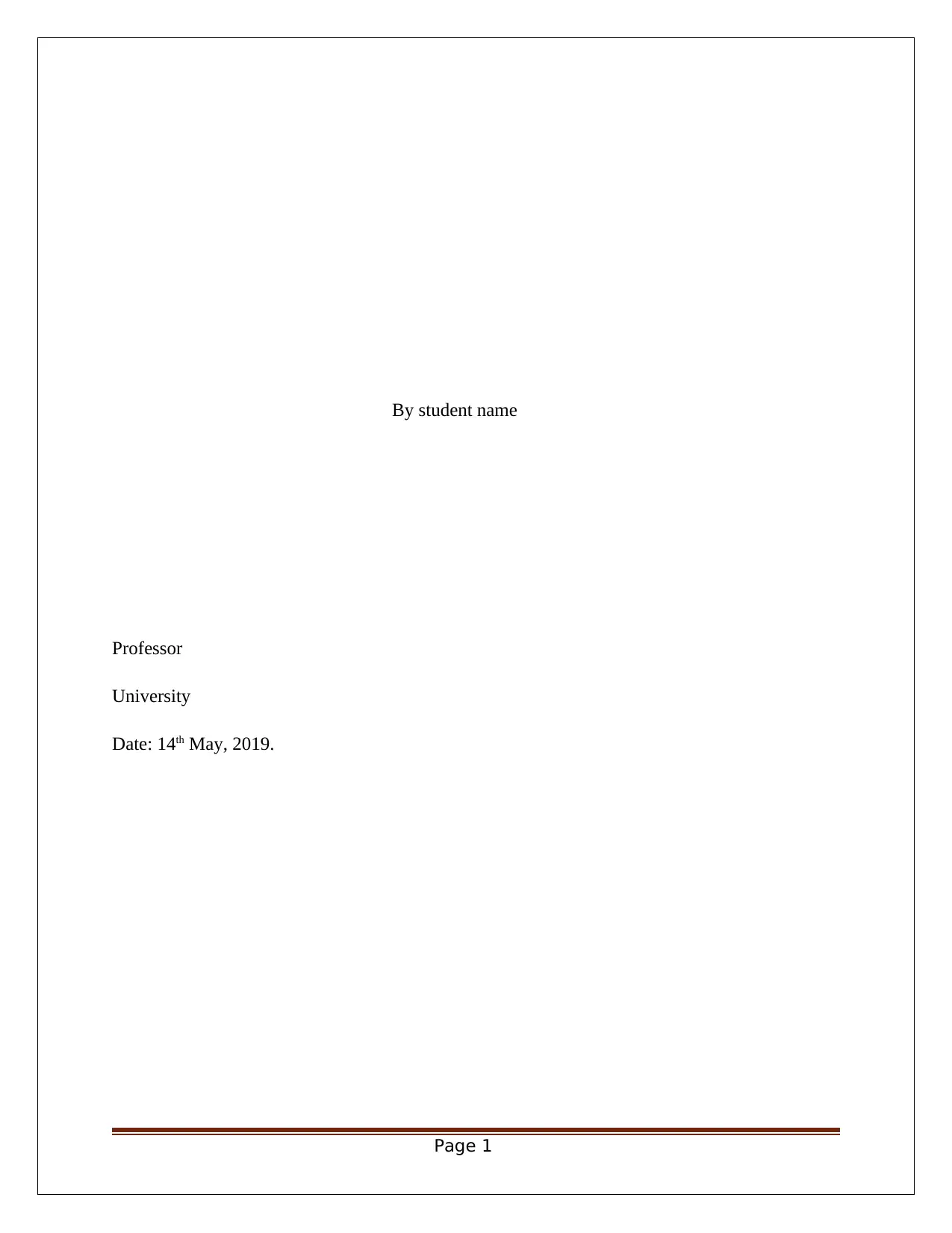
By student name
Professor
University
Date: 14th May, 2019.
Page 1
Professor
University
Date: 14th May, 2019.
Page 1
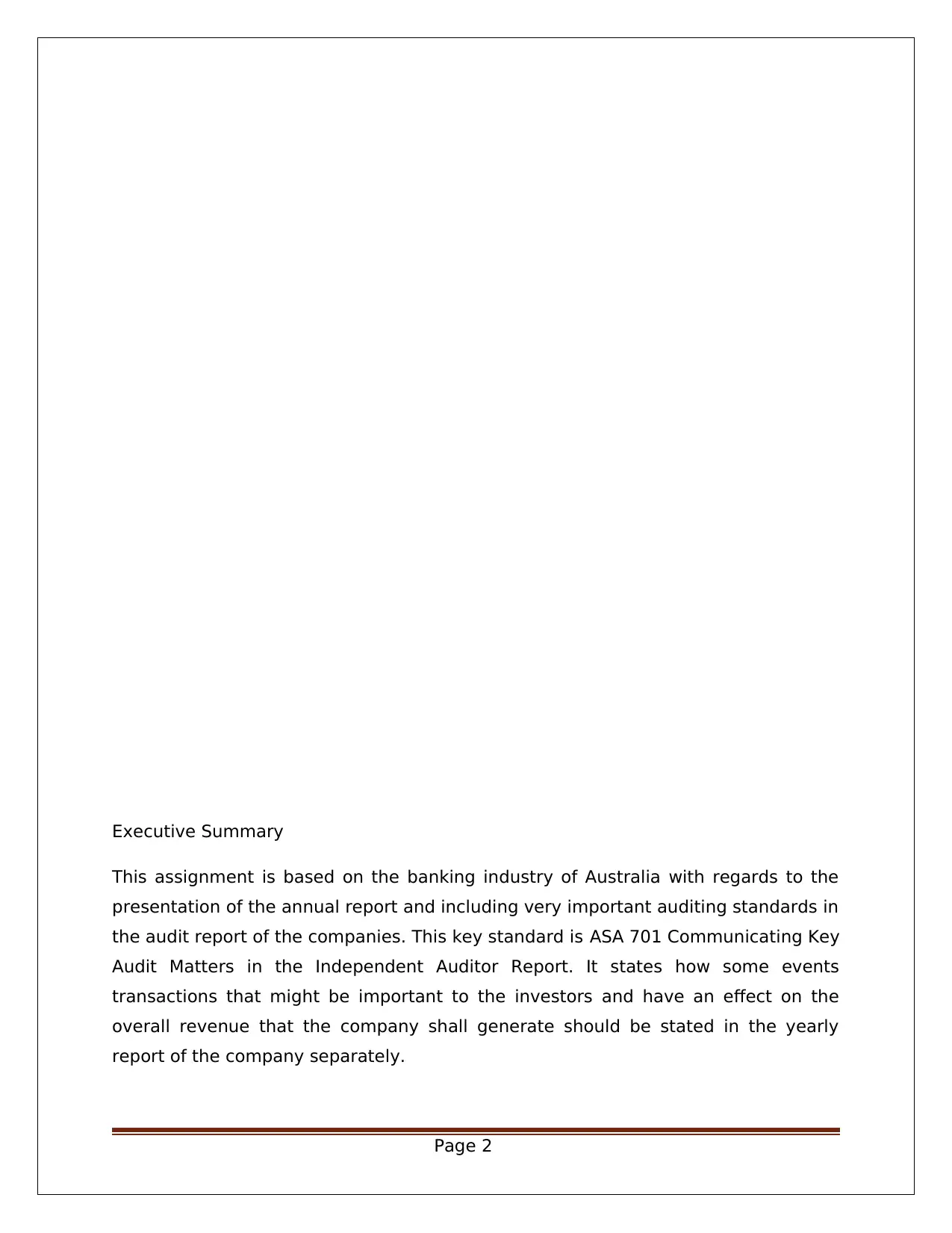
Executive Summary
This assignment is based on the banking industry of Australia with regards to the
presentation of the annual report and including very important auditing standards in
the audit report of the companies. This key standard is ASA 701 Communicating Key
Audit Matters in the Independent Auditor Report. It states how some events
transactions that might be important to the investors and have an effect on the
overall revenue that the company shall generate should be stated in the yearly
report of the company separately.
Page 2
This assignment is based on the banking industry of Australia with regards to the
presentation of the annual report and including very important auditing standards in
the audit report of the companies. This key standard is ASA 701 Communicating Key
Audit Matters in the Independent Auditor Report. It states how some events
transactions that might be important to the investors and have an effect on the
overall revenue that the company shall generate should be stated in the yearly
report of the company separately.
Page 2
⊘ This is a preview!⊘
Do you want full access?
Subscribe today to unlock all pages.

Trusted by 1+ million students worldwide

Table of Contents
Introduction................................................................................................................ 4
Analysis...................................................................................................................... 4
Commonwealth Bank of Australia...............................................................................5
ANZ Banking Company............................................................................................... 7
Conclusion and Recommendation..............................................................................8
References............................................................................................................... 10
Page 3
Introduction................................................................................................................ 4
Analysis...................................................................................................................... 4
Commonwealth Bank of Australia...............................................................................5
ANZ Banking Company............................................................................................... 7
Conclusion and Recommendation..............................................................................8
References............................................................................................................... 10
Page 3
Paraphrase This Document
Need a fresh take? Get an instant paraphrase of this document with our AI Paraphraser
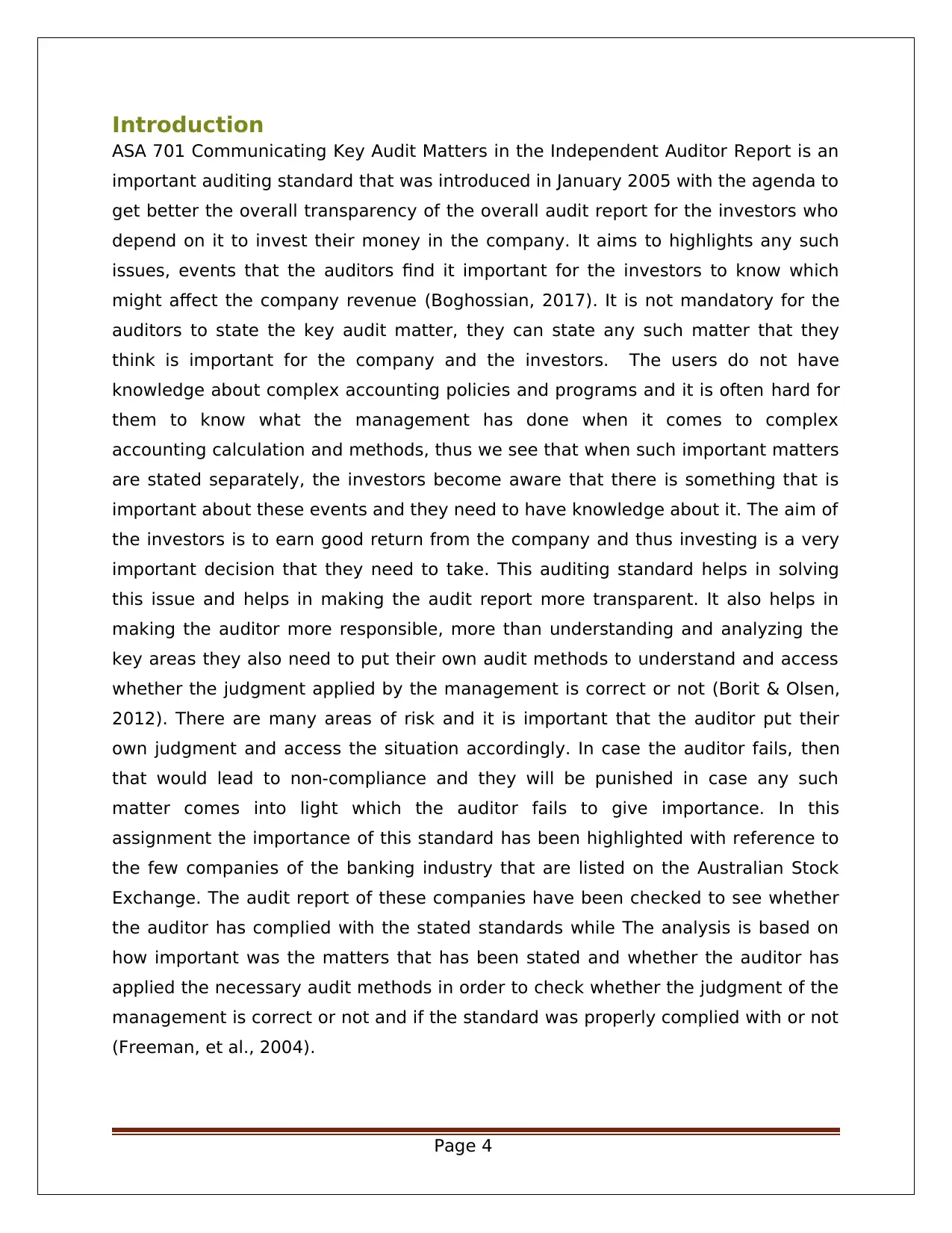
Introduction
ASA 701 Communicating Key Audit Matters in the Independent Auditor Report is an
important auditing standard that was introduced in January 2005 with the agenda to
get better the overall transparency of the overall audit report for the investors who
depend on it to invest their money in the company. It aims to highlights any such
issues, events that the auditors find it important for the investors to know which
might affect the company revenue (Boghossian, 2017). It is not mandatory for the
auditors to state the key audit matter, they can state any such matter that they
think is important for the company and the investors. The users do not have
knowledge about complex accounting policies and programs and it is often hard for
them to know what the management has done when it comes to complex
accounting calculation and methods, thus we see that when such important matters
are stated separately, the investors become aware that there is something that is
important about these events and they need to have knowledge about it. The aim of
the investors is to earn good return from the company and thus investing is a very
important decision that they need to take. This auditing standard helps in solving
this issue and helps in making the audit report more transparent. It also helps in
making the auditor more responsible, more than understanding and analyzing the
key areas they also need to put their own audit methods to understand and access
whether the judgment applied by the management is correct or not (Borit & Olsen,
2012). There are many areas of risk and it is important that the auditor put their
own judgment and access the situation accordingly. In case the auditor fails, then
that would lead to non-compliance and they will be punished in case any such
matter comes into light which the auditor fails to give importance. In this
assignment the importance of this standard has been highlighted with reference to
the few companies of the banking industry that are listed on the Australian Stock
Exchange. The audit report of these companies have been checked to see whether
the auditor has complied with the stated standards while The analysis is based on
how important was the matters that has been stated and whether the auditor has
applied the necessary audit methods in order to check whether the judgment of the
management is correct or not and if the standard was properly complied with or not
(Freeman, et al., 2004).
Page 4
ASA 701 Communicating Key Audit Matters in the Independent Auditor Report is an
important auditing standard that was introduced in January 2005 with the agenda to
get better the overall transparency of the overall audit report for the investors who
depend on it to invest their money in the company. It aims to highlights any such
issues, events that the auditors find it important for the investors to know which
might affect the company revenue (Boghossian, 2017). It is not mandatory for the
auditors to state the key audit matter, they can state any such matter that they
think is important for the company and the investors. The users do not have
knowledge about complex accounting policies and programs and it is often hard for
them to know what the management has done when it comes to complex
accounting calculation and methods, thus we see that when such important matters
are stated separately, the investors become aware that there is something that is
important about these events and they need to have knowledge about it. The aim of
the investors is to earn good return from the company and thus investing is a very
important decision that they need to take. This auditing standard helps in solving
this issue and helps in making the audit report more transparent. It also helps in
making the auditor more responsible, more than understanding and analyzing the
key areas they also need to put their own audit methods to understand and access
whether the judgment applied by the management is correct or not (Borit & Olsen,
2012). There are many areas of risk and it is important that the auditor put their
own judgment and access the situation accordingly. In case the auditor fails, then
that would lead to non-compliance and they will be punished in case any such
matter comes into light which the auditor fails to give importance. In this
assignment the importance of this standard has been highlighted with reference to
the few companies of the banking industry that are listed on the Australian Stock
Exchange. The audit report of these companies have been checked to see whether
the auditor has complied with the stated standards while The analysis is based on
how important was the matters that has been stated and whether the auditor has
applied the necessary audit methods in order to check whether the judgment of the
management is correct or not and if the standard was properly complied with or not
(Freeman, et al., 2004).
Page 4
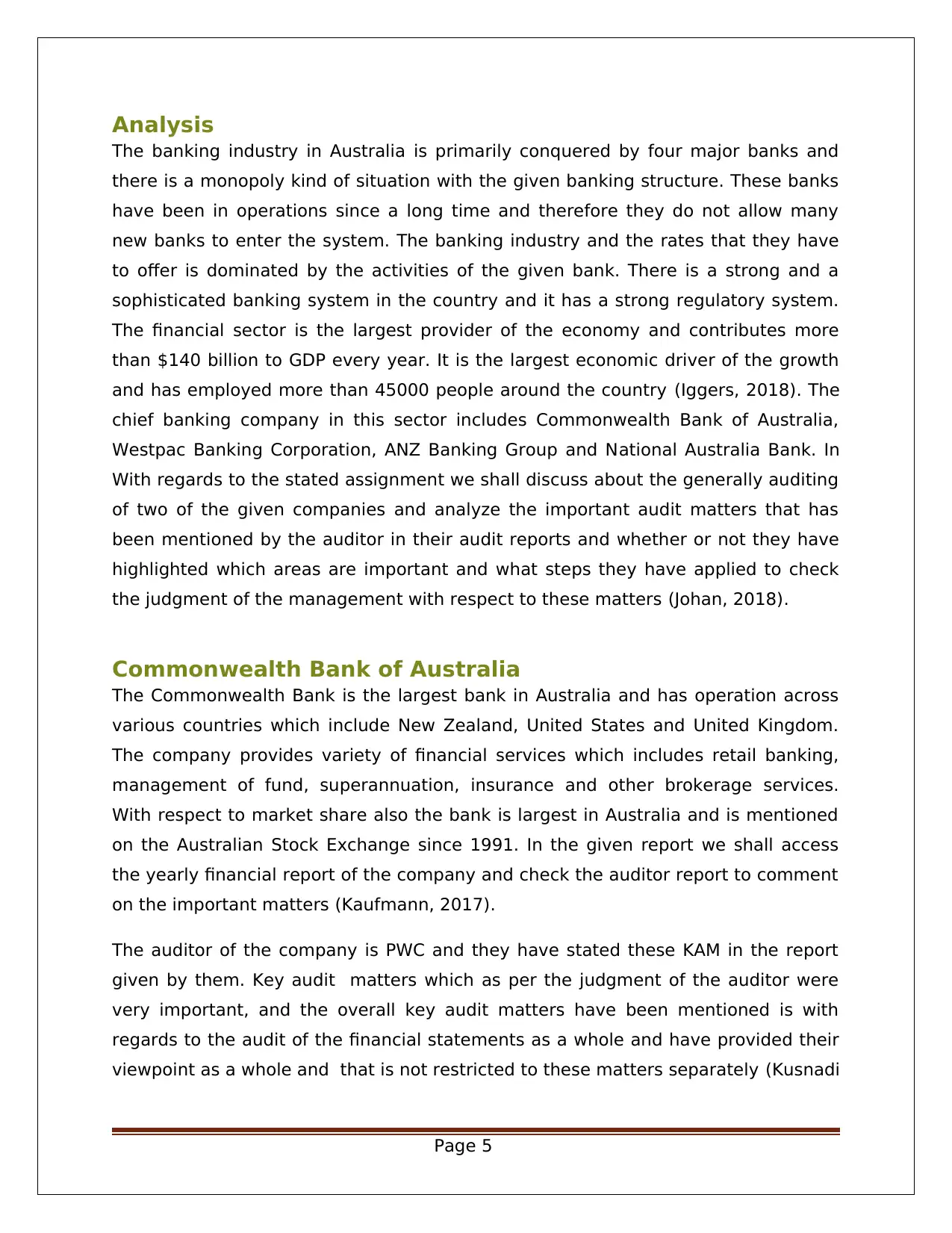
Analysis
The banking industry in Australia is primarily conquered by four major banks and
there is a monopoly kind of situation with the given banking structure. These banks
have been in operations since a long time and therefore they do not allow many
new banks to enter the system. The banking industry and the rates that they have
to offer is dominated by the activities of the given bank. There is a strong and a
sophisticated banking system in the country and it has a strong regulatory system.
The financial sector is the largest provider of the economy and contributes more
than $140 billion to GDP every year. It is the largest economic driver of the growth
and has employed more than 45000 people around the country (Iggers, 2018). The
chief banking company in this sector includes Commonwealth Bank of Australia,
Westpac Banking Corporation, ANZ Banking Group and National Australia Bank. In
With regards to the stated assignment we shall discuss about the generally auditing
of two of the given companies and analyze the important audit matters that has
been mentioned by the auditor in their audit reports and whether or not they have
highlighted which areas are important and what steps they have applied to check
the judgment of the management with respect to these matters (Johan, 2018).
Commonwealth Bank of Australia
The Commonwealth Bank is the largest bank in Australia and has operation across
various countries which include New Zealand, United States and United Kingdom.
The company provides variety of financial services which includes retail banking,
management of fund, superannuation, insurance and other brokerage services.
With respect to market share also the bank is largest in Australia and is mentioned
on the Australian Stock Exchange since 1991. In the given report we shall access
the yearly financial report of the company and check the auditor report to comment
on the important matters (Kaufmann, 2017).
The auditor of the company is PWC and they have stated these KAM in the report
given by them. Key audit matters which as per the judgment of the auditor were
very important, and the overall key audit matters have been mentioned is with
regards to the audit of the financial statements as a whole and have provided their
viewpoint as a whole and that is not restricted to these matters separately (Kusnadi
Page 5
The banking industry in Australia is primarily conquered by four major banks and
there is a monopoly kind of situation with the given banking structure. These banks
have been in operations since a long time and therefore they do not allow many
new banks to enter the system. The banking industry and the rates that they have
to offer is dominated by the activities of the given bank. There is a strong and a
sophisticated banking system in the country and it has a strong regulatory system.
The financial sector is the largest provider of the economy and contributes more
than $140 billion to GDP every year. It is the largest economic driver of the growth
and has employed more than 45000 people around the country (Iggers, 2018). The
chief banking company in this sector includes Commonwealth Bank of Australia,
Westpac Banking Corporation, ANZ Banking Group and National Australia Bank. In
With regards to the stated assignment we shall discuss about the generally auditing
of two of the given companies and analyze the important audit matters that has
been mentioned by the auditor in their audit reports and whether or not they have
highlighted which areas are important and what steps they have applied to check
the judgment of the management with respect to these matters (Johan, 2018).
Commonwealth Bank of Australia
The Commonwealth Bank is the largest bank in Australia and has operation across
various countries which include New Zealand, United States and United Kingdom.
The company provides variety of financial services which includes retail banking,
management of fund, superannuation, insurance and other brokerage services.
With respect to market share also the bank is largest in Australia and is mentioned
on the Australian Stock Exchange since 1991. In the given report we shall access
the yearly financial report of the company and check the auditor report to comment
on the important matters (Kaufmann, 2017).
The auditor of the company is PWC and they have stated these KAM in the report
given by them. Key audit matters which as per the judgment of the auditor were
very important, and the overall key audit matters have been mentioned is with
regards to the audit of the financial statements as a whole and have provided their
viewpoint as a whole and that is not restricted to these matters separately (Kusnadi
Page 5
⊘ This is a preview!⊘
Do you want full access?
Subscribe today to unlock all pages.

Trusted by 1+ million students worldwide
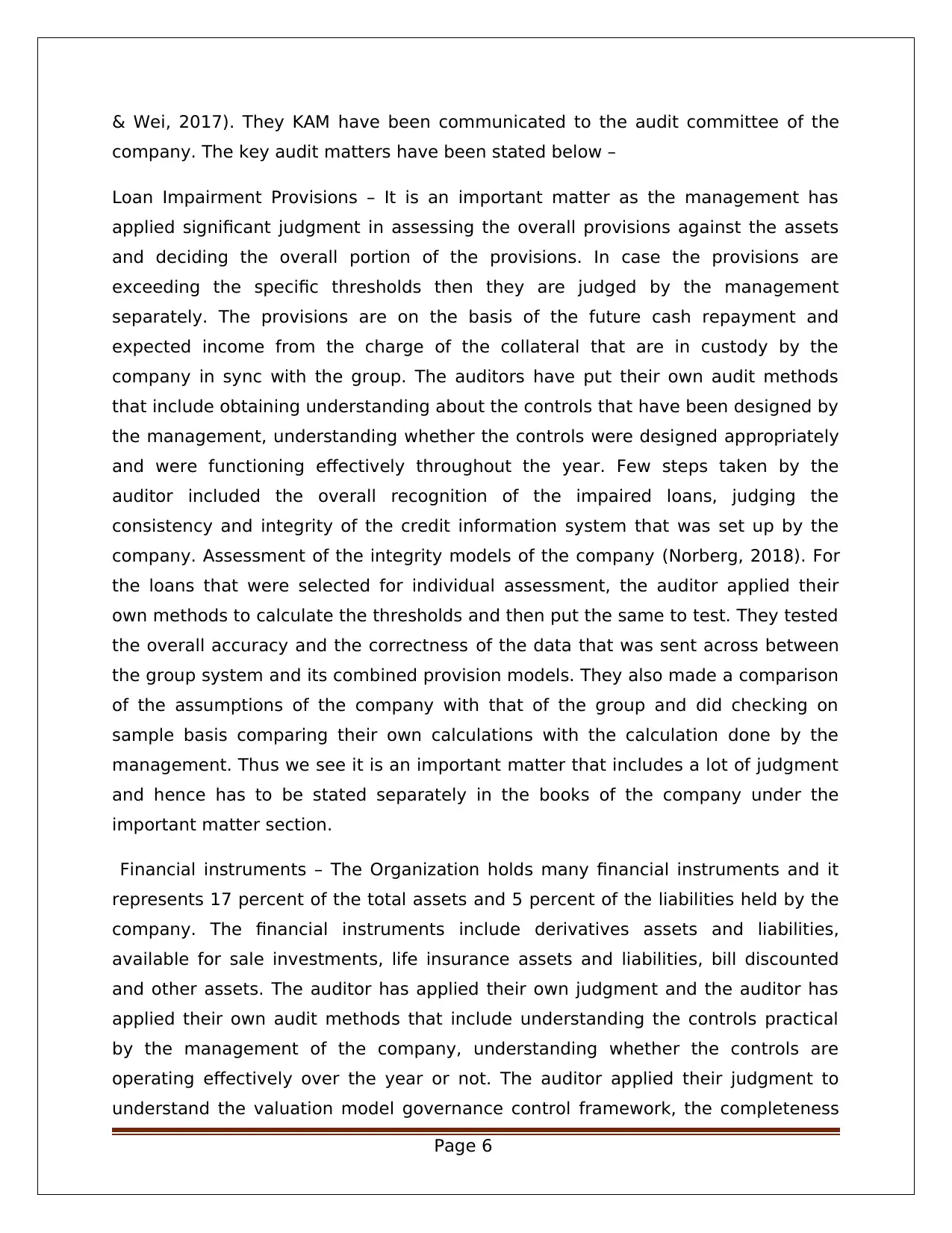
& Wei, 2017). They KAM have been communicated to the audit committee of the
company. The key audit matters have been stated below –
Loan Impairment Provisions – It is an important matter as the management has
applied significant judgment in assessing the overall provisions against the assets
and deciding the overall portion of the provisions. In case the provisions are
exceeding the specific thresholds then they are judged by the management
separately. The provisions are on the basis of the future cash repayment and
expected income from the charge of the collateral that are in custody by the
company in sync with the group. The auditors have put their own audit methods
that include obtaining understanding about the controls that have been designed by
the management, understanding whether the controls were designed appropriately
and were functioning effectively throughout the year. Few steps taken by the
auditor included the overall recognition of the impaired loans, judging the
consistency and integrity of the credit information system that was set up by the
company. Assessment of the integrity models of the company (Norberg, 2018). For
the loans that were selected for individual assessment, the auditor applied their
own methods to calculate the thresholds and then put the same to test. They tested
the overall accuracy and the correctness of the data that was sent across between
the group system and its combined provision models. They also made a comparison
of the assumptions of the company with that of the group and did checking on
sample basis comparing their own calculations with the calculation done by the
management. Thus we see it is an important matter that includes a lot of judgment
and hence has to be stated separately in the books of the company under the
important matter section.
Financial instruments – The Organization holds many financial instruments and it
represents 17 percent of the total assets and 5 percent of the liabilities held by the
company. The financial instruments include derivatives assets and liabilities,
available for sale investments, life insurance assets and liabilities, bill discounted
and other assets. The auditor has applied their own judgment and the auditor has
applied their own audit methods that include understanding the controls practical
by the management of the company, understanding whether the controls are
operating effectively over the year or not. The auditor applied their judgment to
understand the valuation model governance control framework, the completeness
Page 6
company. The key audit matters have been stated below –
Loan Impairment Provisions – It is an important matter as the management has
applied significant judgment in assessing the overall provisions against the assets
and deciding the overall portion of the provisions. In case the provisions are
exceeding the specific thresholds then they are judged by the management
separately. The provisions are on the basis of the future cash repayment and
expected income from the charge of the collateral that are in custody by the
company in sync with the group. The auditors have put their own audit methods
that include obtaining understanding about the controls that have been designed by
the management, understanding whether the controls were designed appropriately
and were functioning effectively throughout the year. Few steps taken by the
auditor included the overall recognition of the impaired loans, judging the
consistency and integrity of the credit information system that was set up by the
company. Assessment of the integrity models of the company (Norberg, 2018). For
the loans that were selected for individual assessment, the auditor applied their
own methods to calculate the thresholds and then put the same to test. They tested
the overall accuracy and the correctness of the data that was sent across between
the group system and its combined provision models. They also made a comparison
of the assumptions of the company with that of the group and did checking on
sample basis comparing their own calculations with the calculation done by the
management. Thus we see it is an important matter that includes a lot of judgment
and hence has to be stated separately in the books of the company under the
important matter section.
Financial instruments – The Organization holds many financial instruments and it
represents 17 percent of the total assets and 5 percent of the liabilities held by the
company. The financial instruments include derivatives assets and liabilities,
available for sale investments, life insurance assets and liabilities, bill discounted
and other assets. The auditor has applied their own judgment and the auditor has
applied their own audit methods that include understanding the controls practical
by the management of the company, understanding whether the controls are
operating effectively over the year or not. The auditor applied their judgment to
understand the valuation model governance control framework, the completeness
Page 6
Paraphrase This Document
Need a fresh take? Get an instant paraphrase of this document with our AI Paraphraser
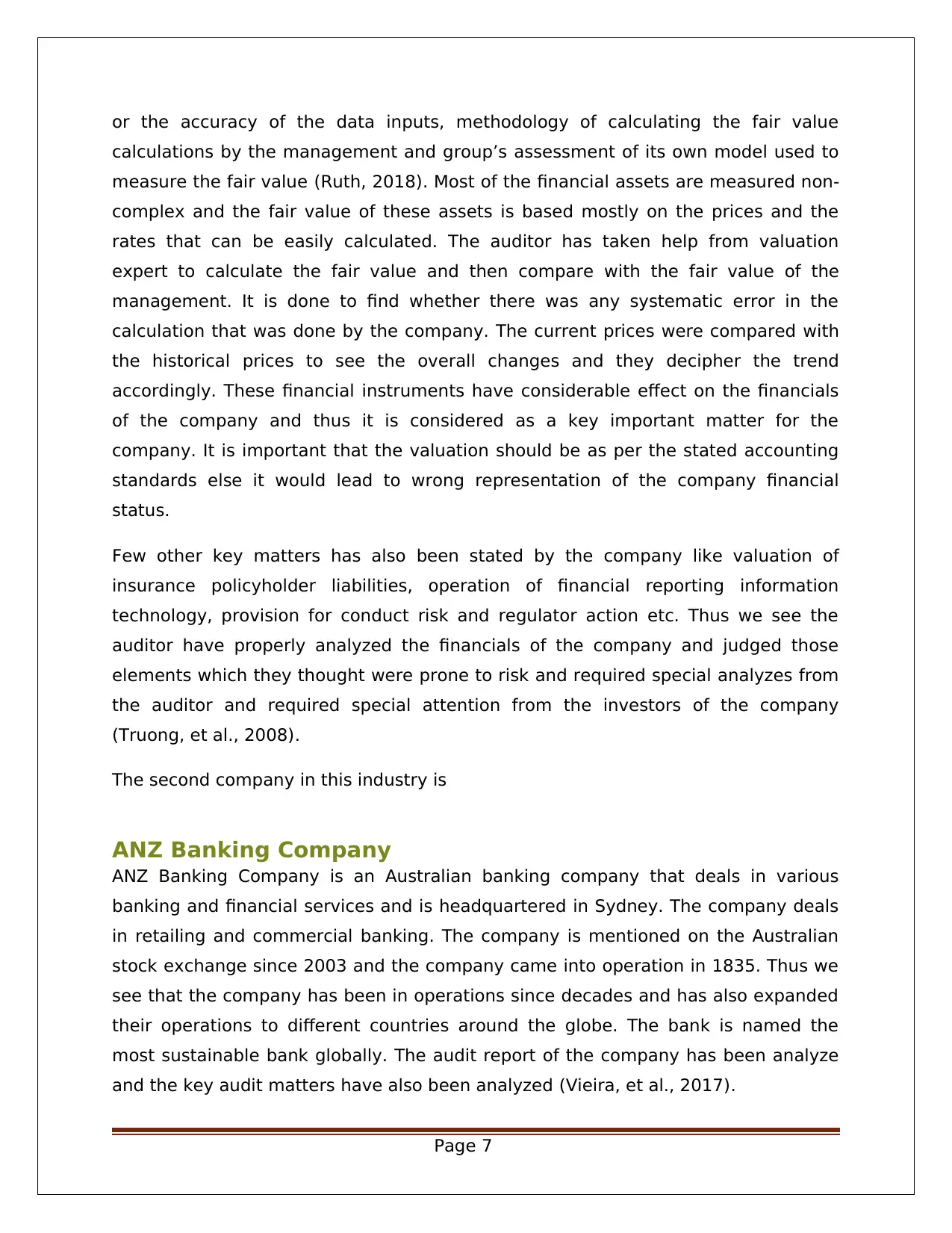
or the accuracy of the data inputs, methodology of calculating the fair value
calculations by the management and group’s assessment of its own model used to
measure the fair value (Ruth, 2018). Most of the financial assets are measured non-
complex and the fair value of these assets is based mostly on the prices and the
rates that can be easily calculated. The auditor has taken help from valuation
expert to calculate the fair value and then compare with the fair value of the
management. It is done to find whether there was any systematic error in the
calculation that was done by the company. The current prices were compared with
the historical prices to see the overall changes and they decipher the trend
accordingly. These financial instruments have considerable effect on the financials
of the company and thus it is considered as a key important matter for the
company. It is important that the valuation should be as per the stated accounting
standards else it would lead to wrong representation of the company financial
status.
Few other key matters has also been stated by the company like valuation of
insurance policyholder liabilities, operation of financial reporting information
technology, provision for conduct risk and regulator action etc. Thus we see the
auditor have properly analyzed the financials of the company and judged those
elements which they thought were prone to risk and required special analyzes from
the auditor and required special attention from the investors of the company
(Truong, et al., 2008).
The second company in this industry is
ANZ Banking Company
ANZ Banking Company is an Australian banking company that deals in various
banking and financial services and is headquartered in Sydney. The company deals
in retailing and commercial banking. The company is mentioned on the Australian
stock exchange since 2003 and the company came into operation in 1835. Thus we
see that the company has been in operations since decades and has also expanded
their operations to different countries around the globe. The bank is named the
most sustainable bank globally. The audit report of the company has been analyze
and the key audit matters have also been analyzed (Vieira, et al., 2017).
Page 7
calculations by the management and group’s assessment of its own model used to
measure the fair value (Ruth, 2018). Most of the financial assets are measured non-
complex and the fair value of these assets is based mostly on the prices and the
rates that can be easily calculated. The auditor has taken help from valuation
expert to calculate the fair value and then compare with the fair value of the
management. It is done to find whether there was any systematic error in the
calculation that was done by the company. The current prices were compared with
the historical prices to see the overall changes and they decipher the trend
accordingly. These financial instruments have considerable effect on the financials
of the company and thus it is considered as a key important matter for the
company. It is important that the valuation should be as per the stated accounting
standards else it would lead to wrong representation of the company financial
status.
Few other key matters has also been stated by the company like valuation of
insurance policyholder liabilities, operation of financial reporting information
technology, provision for conduct risk and regulator action etc. Thus we see the
auditor have properly analyzed the financials of the company and judged those
elements which they thought were prone to risk and required special analyzes from
the auditor and required special attention from the investors of the company
(Truong, et al., 2008).
The second company in this industry is
ANZ Banking Company
ANZ Banking Company is an Australian banking company that deals in various
banking and financial services and is headquartered in Sydney. The company deals
in retailing and commercial banking. The company is mentioned on the Australian
stock exchange since 2003 and the company came into operation in 1835. Thus we
see that the company has been in operations since decades and has also expanded
their operations to different countries around the globe. The bank is named the
most sustainable bank globally. The audit report of the company has been analyze
and the key audit matters have also been analyzed (Vieira, et al., 2017).
Page 7

The auditor of the company is KPMG and they have confirmed the company has
organized their financials on the basis of the authorized accounting and auditing
standards and it is free from all kind of mistakes. The auditor have also mentioned
few key audit matters which they find relevant, these key audit matters and the
opinion that has been framed is as a whole on the financials of the company and
not in parts. The kAM are those which the auditors found are of importance and
which they feel should be informed to the investors. Few of them are stated below-
Provision for Credit Impairment – It is an important matter as the company
has important credit exposure many counterparties across a broad range of
leading and several products, industries and other areas. The value of loan is
significant and thus the auditor has applied their own methods to analyze the
same. The methods includes understanding the controls that have been
applied by the company, testing the key controls over counterparty risk
grading, performing credit assessments through samples of wholesale loans
that are managed by the specialists of the group. The auditor also took help
from valuation experts to check the overall authenticity of the calculations
done by the company. In case of retail loans, there was testing of controls
over the system which was related to the lending arrears, group delinquency
based on the number of days the loan was undertaken (Webster, 2017).
Sample testing was also done by the company. The auditor also did testing of
the provisions estimated across loan portfolios, through test of controls,
checking the assumptions undertaken by the management, testing the
accuracy of the key controls applied, checking samples of retail and
wholesale portfolios among others. Thus it is a significant transaction and
thus the auditor has applied their own judgment and analysis to check the
authenticity of the same.
Valuation of the financial instruments- The financial instruments are an
important part of the financials of the company including 24 percent of assets
and 14 percent of liabilities. The management has applied their own
judgment in judging the fair value of the financial instruments and stated the
same in the notes of the company. The auditor have applied their own
method that includes testing access rights and change management controls,
testing interface controls, notably the overall completeness and accuracy of
Page 8
organized their financials on the basis of the authorized accounting and auditing
standards and it is free from all kind of mistakes. The auditor have also mentioned
few key audit matters which they find relevant, these key audit matters and the
opinion that has been framed is as a whole on the financials of the company and
not in parts. The kAM are those which the auditors found are of importance and
which they feel should be informed to the investors. Few of them are stated below-
Provision for Credit Impairment – It is an important matter as the company
has important credit exposure many counterparties across a broad range of
leading and several products, industries and other areas. The value of loan is
significant and thus the auditor has applied their own methods to analyze the
same. The methods includes understanding the controls that have been
applied by the company, testing the key controls over counterparty risk
grading, performing credit assessments through samples of wholesale loans
that are managed by the specialists of the group. The auditor also took help
from valuation experts to check the overall authenticity of the calculations
done by the company. In case of retail loans, there was testing of controls
over the system which was related to the lending arrears, group delinquency
based on the number of days the loan was undertaken (Webster, 2017).
Sample testing was also done by the company. The auditor also did testing of
the provisions estimated across loan portfolios, through test of controls,
checking the assumptions undertaken by the management, testing the
accuracy of the key controls applied, checking samples of retail and
wholesale portfolios among others. Thus it is a significant transaction and
thus the auditor has applied their own judgment and analysis to check the
authenticity of the same.
Valuation of the financial instruments- The financial instruments are an
important part of the financials of the company including 24 percent of assets
and 14 percent of liabilities. The management has applied their own
judgment in judging the fair value of the financial instruments and stated the
same in the notes of the company. The auditor have applied their own
method that includes testing access rights and change management controls,
testing interface controls, notably the overall completeness and accuracy of
Page 8
⊘ This is a preview!⊘
Do you want full access?
Subscribe today to unlock all pages.

Trusted by 1+ million students worldwide

data transfers, testing the management review and the assumptions done by
them through help taken from the specialists and checking their valuation to
the management valuation. Thus we see that this is having significant
outcome on the overall statements of the company and thus the auditors
have stated it separately (Wendt, 2018).
The other key audit matters have been stated by the auditors includes provision of
customer remediation, accounting for disinvestments and IT system and controls.
All of these have been stated separately and have also stated specific steps that
they have taken to check these important matters and state if the auditors have
applied the needed steps or not to check these accounts and events. Thus users
can go through these and then decide whether they are putting their money in the
company or not (Wellmer, 2018). They can also check the annual report of the prior
year, check the KAM stated there and then decide how the company has progressed
over the year and compare the historical growth with the current growth and then
decide whether it would be profitable if they are investing in the company or not.
Conclusion and Recommendation
Based on the overall study, we can reach to a conclusion that the auditor have
followed the auditing standard and have complied with all the relevant provisions.
The audit report have been made without any errors and the auditor have done
their work properly and have stated all those matters which they thought were
important and deserves specific mention in the audit report as per the ASA 701
auditing standard. So we see that this has overall been instrumental in improving
the overall value of audit and has also helped the stakeholders to understand what
the areas in which they need to focus are. Thus we see that they have followed the
provisions of the given standard very accurately and the same can be seen from the
audit report of the companies stated above. The auditors have presented all the
information in the best ways possible and improved the quality of the audit report. It
will help the auditors in the long run and the stakeholders also when they decide
whether they are investing in the company or not. Having knowledge about the
crucial affairs of the company is important in several ways and if the stakeholders
Page 9
them through help taken from the specialists and checking their valuation to
the management valuation. Thus we see that this is having significant
outcome on the overall statements of the company and thus the auditors
have stated it separately (Wendt, 2018).
The other key audit matters have been stated by the auditors includes provision of
customer remediation, accounting for disinvestments and IT system and controls.
All of these have been stated separately and have also stated specific steps that
they have taken to check these important matters and state if the auditors have
applied the needed steps or not to check these accounts and events. Thus users
can go through these and then decide whether they are putting their money in the
company or not (Wellmer, 2018). They can also check the annual report of the prior
year, check the KAM stated there and then decide how the company has progressed
over the year and compare the historical growth with the current growth and then
decide whether it would be profitable if they are investing in the company or not.
Conclusion and Recommendation
Based on the overall study, we can reach to a conclusion that the auditor have
followed the auditing standard and have complied with all the relevant provisions.
The audit report have been made without any errors and the auditor have done
their work properly and have stated all those matters which they thought were
important and deserves specific mention in the audit report as per the ASA 701
auditing standard. So we see that this has overall been instrumental in improving
the overall value of audit and has also helped the stakeholders to understand what
the areas in which they need to focus are. Thus we see that they have followed the
provisions of the given standard very accurately and the same can be seen from the
audit report of the companies stated above. The auditors have presented all the
information in the best ways possible and improved the quality of the audit report. It
will help the auditors in the long run and the stakeholders also when they decide
whether they are investing in the company or not. Having knowledge about the
crucial affairs of the company is important in several ways and if the stakeholders
Page 9
Paraphrase This Document
Need a fresh take? Get an instant paraphrase of this document with our AI Paraphraser

are not aware about that then there are high probability that the company suffer
from high loss and that loss affects the return that they receive from the company.
So overall this standard has been crucial enough in improving the overall
transparency that is related to auditing of the company and increased the
responsibility of the auditors.
References
Boghossian, P., 2017. The Socratic method, defeasibility, and doxastic
responsibility. Educational Philosophy and Theory, 50(3), pp. 244-253.
Borit, M. & Olsen, P., 2012. Evaluation framework for regulatory requirements
related to data recording and traceability designed to prevent illegal, unreported
and unregulated fishing. Marine Policy, 36(1), pp. 96-102.
Freeman, R., Wicks, A. & Parmar, B., 2004. Stakeholder Theory and “The Corporate
Objective Revisited”. Organization Science, 15(3), pp. 22-28.
Iggers, J., 2018. Good News, Bad News: Journalism Ethics And The Public Interest.
s.l.:s.n.
Johan, S., 2018. The Relationship Between Economic Value Added, Market Value
Added And Return On Cost Of Capital In Measuring Corporate Performance. Jurnal
Manajemen Bisnis dan Kewirausahaan, 3(1), pp. 121-134.
Kaufmann, W., 2017. The Problem of Regulatory Unreasonableness. First ed. New
York: Routledge.
Page 10
from high loss and that loss affects the return that they receive from the company.
So overall this standard has been crucial enough in improving the overall
transparency that is related to auditing of the company and increased the
responsibility of the auditors.
References
Boghossian, P., 2017. The Socratic method, defeasibility, and doxastic
responsibility. Educational Philosophy and Theory, 50(3), pp. 244-253.
Borit, M. & Olsen, P., 2012. Evaluation framework for regulatory requirements
related to data recording and traceability designed to prevent illegal, unreported
and unregulated fishing. Marine Policy, 36(1), pp. 96-102.
Freeman, R., Wicks, A. & Parmar, B., 2004. Stakeholder Theory and “The Corporate
Objective Revisited”. Organization Science, 15(3), pp. 22-28.
Iggers, J., 2018. Good News, Bad News: Journalism Ethics And The Public Interest.
s.l.:s.n.
Johan, S., 2018. The Relationship Between Economic Value Added, Market Value
Added And Return On Cost Of Capital In Measuring Corporate Performance. Jurnal
Manajemen Bisnis dan Kewirausahaan, 3(1), pp. 121-134.
Kaufmann, W., 2017. The Problem of Regulatory Unreasonableness. First ed. New
York: Routledge.
Page 10
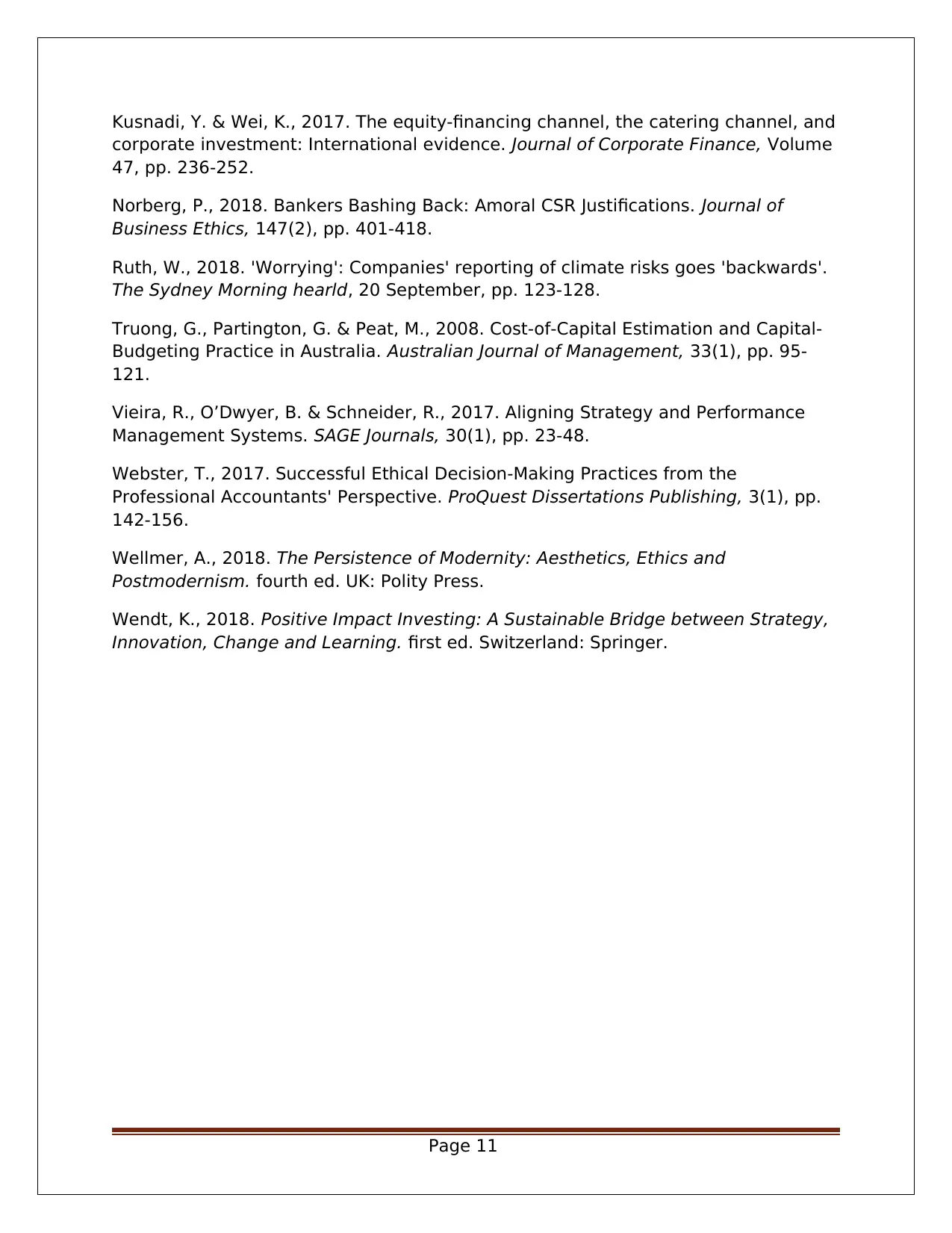
Kusnadi, Y. & Wei, K., 2017. The equity-financing channel, the catering channel, and
corporate investment: International evidence. Journal of Corporate Finance, Volume
47, pp. 236-252.
Norberg, P., 2018. Bankers Bashing Back: Amoral CSR Justifications. Journal of
Business Ethics, 147(2), pp. 401-418.
Ruth, W., 2018. 'Worrying': Companies' reporting of climate risks goes 'backwards'.
The Sydney Morning hearld, 20 September, pp. 123-128.
Truong, G., Partington, G. & Peat, M., 2008. Cost-of-Capital Estimation and Capital-
Budgeting Practice in Australia. Australian Journal of Management, 33(1), pp. 95-
121.
Vieira, R., O’Dwyer, B. & Schneider, R., 2017. Aligning Strategy and Performance
Management Systems. SAGE Journals, 30(1), pp. 23-48.
Webster, T., 2017. Successful Ethical Decision-Making Practices from the
Professional Accountants' Perspective. ProQuest Dissertations Publishing, 3(1), pp.
142-156.
Wellmer, A., 2018. The Persistence of Modernity: Aesthetics, Ethics and
Postmodernism. fourth ed. UK: Polity Press.
Wendt, K., 2018. Positive Impact Investing: A Sustainable Bridge between Strategy,
Innovation, Change and Learning. first ed. Switzerland: Springer.
Page 11
corporate investment: International evidence. Journal of Corporate Finance, Volume
47, pp. 236-252.
Norberg, P., 2018. Bankers Bashing Back: Amoral CSR Justifications. Journal of
Business Ethics, 147(2), pp. 401-418.
Ruth, W., 2018. 'Worrying': Companies' reporting of climate risks goes 'backwards'.
The Sydney Morning hearld, 20 September, pp. 123-128.
Truong, G., Partington, G. & Peat, M., 2008. Cost-of-Capital Estimation and Capital-
Budgeting Practice in Australia. Australian Journal of Management, 33(1), pp. 95-
121.
Vieira, R., O’Dwyer, B. & Schneider, R., 2017. Aligning Strategy and Performance
Management Systems. SAGE Journals, 30(1), pp. 23-48.
Webster, T., 2017. Successful Ethical Decision-Making Practices from the
Professional Accountants' Perspective. ProQuest Dissertations Publishing, 3(1), pp.
142-156.
Wellmer, A., 2018. The Persistence of Modernity: Aesthetics, Ethics and
Postmodernism. fourth ed. UK: Polity Press.
Wendt, K., 2018. Positive Impact Investing: A Sustainable Bridge between Strategy,
Innovation, Change and Learning. first ed. Switzerland: Springer.
Page 11
⊘ This is a preview!⊘
Do you want full access?
Subscribe today to unlock all pages.

Trusted by 1+ million students worldwide
1 out of 12
Related Documents
Your All-in-One AI-Powered Toolkit for Academic Success.
+13062052269
info@desklib.com
Available 24*7 on WhatsApp / Email
![[object Object]](/_next/static/media/star-bottom.7253800d.svg)
Unlock your academic potential
© 2024 | Zucol Services PVT LTD | All rights reserved.




